 Memorials: Berlin
Memorials: Berlin
by Ayesha Adamo
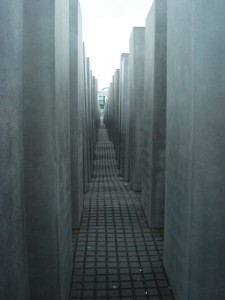 While in Berlin, I visited two large-scale Holocaust memorials – one was the well-publicized and controversial Holocaust Memorial near the Brandenburg Gate; the other was Gleis 17, a seemingly less known spot at Grünewald Station on the S-Bahn.
The official title of the first memorial is Denkmal für die emordeten Juden Europas, or Memorial to the Murdered Jews of Europe, but no one seems to want to use this title. Most just call it Holocaust Memorial and everyone appears to know which one you mean, which is amazing when you consider that every turn of a street corner in Berlin brings a different plaque or statue to be discovered. Whether it be names and dates in brass on the ground, bullet dents building character on a beautiful facade, or the graffiti that’s left up for posterity, every manmade surface in Berlin carries the marks of who-wuz-here and what happened before, one great layer of impasto after another.
The Holocaust Memorial doesn’t have graffiti, though, which has been cause for much controversy – not because people feel that it would be better with graffiti, but because Degussa, the company that made the graffiti-proof coating for the large stone slabs that populate this monument, also made Zyklon B during WWII.
While the inclusion of the word “Murdered” in the Memorial’s full title has the sound of something flashy, the actual monument is stoic and austere. Each of the rectangular stones is of a different height, and the ground that the stones stand on has visible waves of hills and valleys, creating a kind of visual discord that, like the event the
While in Berlin, I visited two large-scale Holocaust memorials – one was the well-publicized and controversial Holocaust Memorial near the Brandenburg Gate; the other was Gleis 17, a seemingly less known spot at Grünewald Station on the S-Bahn.
The official title of the first memorial is Denkmal für die emordeten Juden Europas, or Memorial to the Murdered Jews of Europe, but no one seems to want to use this title. Most just call it Holocaust Memorial and everyone appears to know which one you mean, which is amazing when you consider that every turn of a street corner in Berlin brings a different plaque or statue to be discovered. Whether it be names and dates in brass on the ground, bullet dents building character on a beautiful facade, or the graffiti that’s left up for posterity, every manmade surface in Berlin carries the marks of who-wuz-here and what happened before, one great layer of impasto after another.
The Holocaust Memorial doesn’t have graffiti, though, which has been cause for much controversy – not because people feel that it would be better with graffiti, but because Degussa, the company that made the graffiti-proof coating for the large stone slabs that populate this monument, also made Zyklon B during WWII.
While the inclusion of the word “Murdered” in the Memorial’s full title has the sound of something flashy, the actual monument is stoic and austere. Each of the rectangular stones is of a different height, and the ground that the stones stand on has visible waves of hills and valleys, creating a kind of visual discord that, like the event the 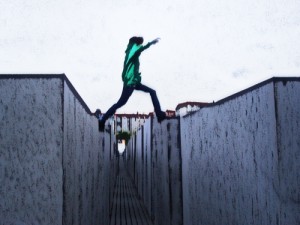 monument recognizes, is difficult to comprehend in any simple kind of understanding. The vertical parallels of stones, and the grey grids created between them, give the feeling of some fleeting yet absolute form and structure, like entering deeper and deeper into the labyrinth of infinity.
The Memorial expects you to be a part of it, to be in it. I watched a group of kids playing games and leaping from stone to stone, a high-stakes version of hopscotch. They were reclaiming the tall grey pillars as their playground in a way that seemed obvious and natural. And why wouldn’t this be a place for play as much as anything else? There are no signs here to state otherwise.
monument recognizes, is difficult to comprehend in any simple kind of understanding. The vertical parallels of stones, and the grey grids created between them, give the feeling of some fleeting yet absolute form and structure, like entering deeper and deeper into the labyrinth of infinity.
The Memorial expects you to be a part of it, to be in it. I watched a group of kids playing games and leaping from stone to stone, a high-stakes version of hopscotch. They were reclaiming the tall grey pillars as their playground in a way that seemed obvious and natural. And why wouldn’t this be a place for play as much as anything else? There are no signs here to state otherwise.
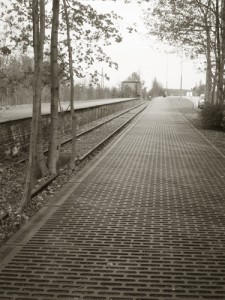
 Gleis 17 was the site of deportations to extermination camps during WWII. The tracks are no longer in use, but remain as part of this memorial, bending off ominously in the distance. Each of the iron grates along the length of the platform is engraved with the date, destination, and number of Jewish passengers on a different deportation.
The tracks here are now quiet and serene. There was hardly anyone else around when I visited, but a fresh single rose left at one of the grates proved that others had been there recently. The only marks of the many that stood there decades before were the numbers pressed into iron every few feet, but there was a feeling about standing there that marked the place unmistakably.
Gleis 17 was the site of deportations to extermination camps during WWII. The tracks are no longer in use, but remain as part of this memorial, bending off ominously in the distance. Each of the iron grates along the length of the platform is engraved with the date, destination, and number of Jewish passengers on a different deportation.
The tracks here are now quiet and serene. There was hardly anyone else around when I visited, but a fresh single rose left at one of the grates proved that others had been there recently. The only marks of the many that stood there decades before were the numbers pressed into iron every few feet, but there was a feeling about standing there that marked the place unmistakably.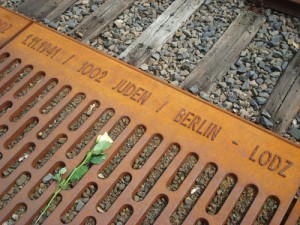 A little dandelion pushing through the platform grate caught my eye, and at one end of the station trees have grown up through parts of the tracks. Here, nature is reclaiming both the tracks and the memorial. New life is filling up all the spaces between grates and between tracks, but when we left on the S-Bahn, there was a Roma playing accordion while his son held a cup out that no one was filling up. Hardly anyone even looked up.
A little dandelion pushing through the platform grate caught my eye, and at one end of the station trees have grown up through parts of the tracks. Here, nature is reclaiming both the tracks and the memorial. New life is filling up all the spaces between grates and between tracks, but when we left on the S-Bahn, there was a Roma playing accordion while his son held a cup out that no one was filling up. Hardly anyone even looked up.
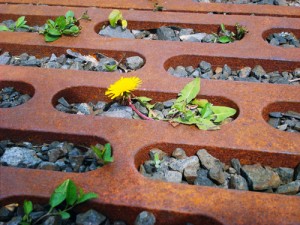
 While in Berlin, I visited two large-scale Holocaust memorials – one was the well-publicized and controversial Holocaust Memorial near the Brandenburg Gate; the other was Gleis 17, a seemingly less known spot at Grünewald Station on the S-Bahn.
The official title of the first memorial is Denkmal für die emordeten Juden Europas, or Memorial to the Murdered Jews of Europe, but no one seems to want to use this title. Most just call it Holocaust Memorial and everyone appears to know which one you mean, which is amazing when you consider that every turn of a street corner in Berlin brings a different plaque or statue to be discovered. Whether it be names and dates in brass on the ground, bullet dents building character on a beautiful facade, or the graffiti that’s left up for posterity, every manmade surface in Berlin carries the marks of who-wuz-here and what happened before, one great layer of impasto after another.
The Holocaust Memorial doesn’t have graffiti, though, which has been cause for much controversy – not because people feel that it would be better with graffiti, but because Degussa, the company that made the graffiti-proof coating for the large stone slabs that populate this monument, also made Zyklon B during WWII.
While the inclusion of the word “Murdered” in the Memorial’s full title has the sound of something flashy, the actual monument is stoic and austere. Each of the rectangular stones is of a different height, and the ground that the stones stand on has visible waves of hills and valleys, creating a kind of visual discord that, like the event the
While in Berlin, I visited two large-scale Holocaust memorials – one was the well-publicized and controversial Holocaust Memorial near the Brandenburg Gate; the other was Gleis 17, a seemingly less known spot at Grünewald Station on the S-Bahn.
The official title of the first memorial is Denkmal für die emordeten Juden Europas, or Memorial to the Murdered Jews of Europe, but no one seems to want to use this title. Most just call it Holocaust Memorial and everyone appears to know which one you mean, which is amazing when you consider that every turn of a street corner in Berlin brings a different plaque or statue to be discovered. Whether it be names and dates in brass on the ground, bullet dents building character on a beautiful facade, or the graffiti that’s left up for posterity, every manmade surface in Berlin carries the marks of who-wuz-here and what happened before, one great layer of impasto after another.
The Holocaust Memorial doesn’t have graffiti, though, which has been cause for much controversy – not because people feel that it would be better with graffiti, but because Degussa, the company that made the graffiti-proof coating for the large stone slabs that populate this monument, also made Zyklon B during WWII.
While the inclusion of the word “Murdered” in the Memorial’s full title has the sound of something flashy, the actual monument is stoic and austere. Each of the rectangular stones is of a different height, and the ground that the stones stand on has visible waves of hills and valleys, creating a kind of visual discord that, like the event the  monument recognizes, is difficult to comprehend in any simple kind of understanding. The vertical parallels of stones, and the grey grids created between them, give the feeling of some fleeting yet absolute form and structure, like entering deeper and deeper into the labyrinth of infinity.
The Memorial expects you to be a part of it, to be in it. I watched a group of kids playing games and leaping from stone to stone, a high-stakes version of hopscotch. They were reclaiming the tall grey pillars as their playground in a way that seemed obvious and natural. And why wouldn’t this be a place for play as much as anything else? There are no signs here to state otherwise.
monument recognizes, is difficult to comprehend in any simple kind of understanding. The vertical parallels of stones, and the grey grids created between them, give the feeling of some fleeting yet absolute form and structure, like entering deeper and deeper into the labyrinth of infinity.
The Memorial expects you to be a part of it, to be in it. I watched a group of kids playing games and leaping from stone to stone, a high-stakes version of hopscotch. They were reclaiming the tall grey pillars as their playground in a way that seemed obvious and natural. And why wouldn’t this be a place for play as much as anything else? There are no signs here to state otherwise.

 Gleis 17 was the site of deportations to extermination camps during WWII. The tracks are no longer in use, but remain as part of this memorial, bending off ominously in the distance. Each of the iron grates along the length of the platform is engraved with the date, destination, and number of Jewish passengers on a different deportation.
The tracks here are now quiet and serene. There was hardly anyone else around when I visited, but a fresh single rose left at one of the grates proved that others had been there recently. The only marks of the many that stood there decades before were the numbers pressed into iron every few feet, but there was a feeling about standing there that marked the place unmistakably.
Gleis 17 was the site of deportations to extermination camps during WWII. The tracks are no longer in use, but remain as part of this memorial, bending off ominously in the distance. Each of the iron grates along the length of the platform is engraved with the date, destination, and number of Jewish passengers on a different deportation.
The tracks here are now quiet and serene. There was hardly anyone else around when I visited, but a fresh single rose left at one of the grates proved that others had been there recently. The only marks of the many that stood there decades before were the numbers pressed into iron every few feet, but there was a feeling about standing there that marked the place unmistakably. A little dandelion pushing through the platform grate caught my eye, and at one end of the station trees have grown up through parts of the tracks. Here, nature is reclaiming both the tracks and the memorial. New life is filling up all the spaces between grates and between tracks, but when we left on the S-Bahn, there was a Roma playing accordion while his son held a cup out that no one was filling up. Hardly anyone even looked up.
A little dandelion pushing through the platform grate caught my eye, and at one end of the station trees have grown up through parts of the tracks. Here, nature is reclaiming both the tracks and the memorial. New life is filling up all the spaces between grates and between tracks, but when we left on the S-Bahn, there was a Roma playing accordion while his son held a cup out that no one was filling up. Hardly anyone even looked up.


Just came across this by site by accident. One thing:
“And why wouldn’t this be a place for play as much as anything else? There are no signs here to state otherwise.”
There are, actually. The regulations (Besucherordnung) are stated explicitly on signs and are also downloadable online. All activities described – climbing on stones, jumping between them, playing loudly – are proscribed. To my knowledge, these regulations have been posted ever since this Gedenkstätte has existed.